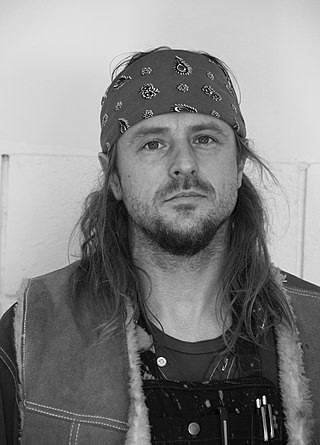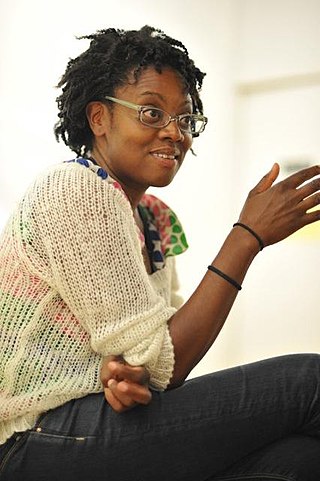Related Research Articles

Robert Gober is an American sculptor. His work is often related to domestic and familiar objects such as sinks, doors, and legs.
Tara Donovan is an American sculptor who lives and works in Brooklyn, New York. Her large-scale installations, sculptures, drawings, and prints utilize everyday objects to explore the transformative effects of accumulation and aggregation. Known for her commitment to process, she has earned acclaim for her ability to exploit the inherent physical characteristics of an object in order to transform it into works that generate unique perceptual phenomena and atmospheric effects. Her work has been conceptually linked to an art historical lineage that includes Postminimalism and Process artists such as Eva Hesse, Jackie Winsor, Richard Serra, and Robert Morris, along with Light and Space artists such as Mary Corse, Helen Pashgian, Robert Irwin, and James Turrell.
Sarah Sze is an American artist and professor of visual arts at Columbia University. Sze's work explores the role of technology, information, and memory with objects in contemporary life utilizing everyday materials. Her work often represents objects caught in suspension. Drawing from Modernist traditions, Sze confronts the relationship between low-value mass-produced objects in high-value institutions, creating the sense that everyday life objects can be art. She has exhibited internationally and her works are in the collections of several major museums.
Jack Pierson is an American photographer and an artist. Pierson is known for his photographs, collages, word sculptures, installations, drawings and artists books. His "Self-Portrait" series was shown in the 2004 Whitney Biennial. His works are held in numerous museum collections.
Rachel Harrison is an American visual artist known for her sculpture, photography, and drawing. Her work often combines handmade forms with found objects or photographs, bringing art history, politics, and pop culture into dialogue with one another. She has been included in numerous exhibitions in Europe and the US, including the Venice Biennale, the Whitney Biennial and the Tate Triennial (2009). Her work is in the collections of major museums such as The Museum of Modern Art, New York; Metropolitan Museum of Art, New York; Hirshhorn Museum and Sculpture Garden, Washington, D.C.; and Tate Modern, London; among others. She lives and works in New York.
Kim Dingle is a Los Angeles-based contemporary artist working across painting, sculpture, photography, found imagery, and installation. Her practice explores themes of American culture, history, and gender politics through both figurative and abstract approaches.

Sterling Ruby is an American artist who works in a large variety of media including ceramics, painting, drawing, collage, sculpture, video, and textiles. Often, his work is presented in large and densely packed installations. The artist has cited a diverse range of sources and influences including aberrant psychologies, urban gangs and graffiti, hip-hop culture, craft, punk, masculinity, violence, public art, prisons, globalization, American domination and decline, waste and consumption. In opposition to the minimalist artistic tradition and influenced by the ubiquity of urban graffiti, the artist's works often appear scratched, defaced, camouflaged, dirty, or splattered. Proclaimed as one of the most interesting artists to emerge this century by New York Times art critic Roberta Smith, Ruby's work examines the psychological space where individual expression confronts social constraint. Sterling Ruby currently lives and works in Los Angeles. His studio is located in Vernon, south of downtown Los Angeles.

Katy Schimert is an American artist known for exhibitions and installations that meld disparate media into cohesive formal and conceptual visual statements arising out of personal experience, myth and empirical knowledge. She interweaves elements of fine and decorative arts, figuration and abstraction in densely layered drawings and sculpture that together suggest elliptical narratives or unfolding, cosmic events. Curator Heidi Zuckerman wrote that Schimert is inspired by "the places where the organized and the chaotic intersect—the scientific and the mythic, the known and the unknown, and the real and the imagined … she creates work that exists where, through fantasy, truth and beauty meet."
Paul Sietsema is a Los Angeles–based American artist who works primarily in film, painting and drawing. His work addresses the production, consumption, and proliferation of cultural objects, reflecting his interest in the possibility of an artwork to mediate information or meaning in a way that engages with the aesthetics of a specific time period. In the words of Sarah Robayo Sheridan, “Paul Sietsema compounds organic and artificial detritus in all his artwork, scavenging in history’s wake to identify specific tools of cultural production and foraging for concepts of art promulgated in the words of artists and attitudes of critics. He mines film as a vestige, the medium of the mechanical age, pressing and squeezing its very obsolescence through a contemporary sieve. In so doing, the artist hovers in the switchover between a bodily inscription in the image and a fundamental reconstitution of sight and representation in the matrix of the virtual. Where body stops and image starts is a divide collapsing through a series of innovations and accidents that go back as far as the people of Pompeii trapped in an emulsion that marked their death, but which paradoxically carried forward their image into eternity.”
Gary Simmons is an American artist from New York City. Using icons and stereotypes of American popular culture, he creates works that address personal and collective experiences of race and class. He is best known for his "erasure drawings," in which he draws in white chalk on slate-painted panels or walls, then smudges them with his hands – a technique that renders their imagery ghostly.

Leslie Hewitt is an American contemporary visual artist.
Dawn Kasper is a New York-based interdisciplinary artist working across genres of performance, installation, sculpture, drawing, photography, video, and sound. Her often improvisational work derives from a "fascination with existentialism, subjects of vulnerability, desire, and the construction of meaning." Kasper uses props, costume, comedy, gesture, repetition, music, and monologue to create what she refers to as "living sculptures."

Cauleen Smith is an American born filmmaker and multimedia artist. She is best known for her feature film Drylongso and her experimental works that address the African-American identity, specifically the issues facing black women today. Smith is currently a professor in the Department of Art at the University of California - Los Angeles.
Ellen Brooks is an American photographer. She began her career on the West Coast, and is associated with the Los Angeles–based art community of the late 1960s and '70s. In 1982 she moved to New York, where her practice has since been based. Her work is known for its boundary-pushing forays into sculpture, and for her use of screens and image altering pro-filmic photographic processes. She has shown at the Museum of Modern Art (MOMA), the Whitney Museum of American Art, the Los Angeles Museum of Contemporary Art, and the Centre Pompidou, and has worked in the permanent collections of the MOMA, the Whitney, the National Museum of American Art, the Getty Museum, and others.

Ree Morton was an American visual artist who was closely associated with the postminimalist and feminist art movements of the 1970s.
Lisa Lapinski is an American visual artist who creates dense, formally complex sculptures which utilize both the language of traditional craft and advanced semiotics. Her uncanny objects interrogate the production of desire and the exchange of meaning in an image-based society. Discussing a group show in 2007, New York Times Art Writer Holland Cotter noted, "An installation by Lisa Lapinski carries a hefty theory- studies title: 'Christmas Tea-Meeting, Presented by Dialogue and Humanism, Formerly Dialectics and Humanism.' But the piece itself just looks breezily enigmatic." It is often remarked that viewers of Lapinski's sculptures are enticed into an elaborate set of ritualistic decodings. In a review of her work published in ArtForum, Michael Ned Holte noted, "At such moments, it becomes clear that Lapinski's entire systemic logic is less circular than accumulative: What at first seems hermetically sealed is often surprisingly generous upon sustained investigation." Lapinski's work has been exhibited widely in the US and Europe, and she was included in the 2006 Whitney Biennial.
Jennifer Pastor is an American sculptor and Professor of Visual Arts at the University of California Irvine. Pastor examines issues of space encompassing structure, body and object orientations, imaginary forms, narrative and progressions of sequence.
Danielle Dean is a British-American visual artist. She works in drawing, installation, performance and video. She has exhibited in London and in the United States; her work was included in an exhibition at the Hammer Museum focusing on new or under-recognized artists working in Los Angeles.
Guadalupe Rosales is an American artist and educator. She is best known for her archival projects, “Veteranas and Rucas” and “Map Pointz,” found on social media. The archives focus on Latino backyard party scenes and underground party crew subculture in Los Angeles in the late-twentieth century and early-twenty first.
T. Kelly Mason is a Los Angeles–based post-conceptual artist, writer, and educator who works in a number of media, including video, music, sculpture, and text. Mason has taught at ArtCenter College of Design in Pasadena since 2001.
References
- ↑ whitney.org
- ↑ Sharon Mizota (October 10, 2008), Amanda Ross-Ho at Cherry and Martin Los Angeles Times .
- ↑ Carol Vogel (July 29, 2010), ‘New Photography 2010’ Coming to MoMA The New York Times .
- ↑ Kevin West (May 9, 2014), Sterling Ruby: Balancing Act W .
- ↑ Roberta Smith (February 15, 2008), Art in Review; Amanda Ross-Ho and Kirsten Stoltmann The New York Times .
- 1 2 3 Holly Myers (August 22, 2010), The locus of Amanda Ross-Ho's art Los Angeles Times .
- ↑ "FineArts.USC.edu". Archived from the original on 2007-06-07. Retrieved 2008-03-23.
- ↑ Whitney.org
- ↑ "CherryAndMartin.com". Archived from the original on 2008-04-06. Retrieved 2008-03-23.
- ↑ "MCA Chicago Plaza Project: Amanda Ross-Ho | Exhibitions | MCA Chicago". Archived from the original on 2014-02-04. Retrieved 2014-02-01.